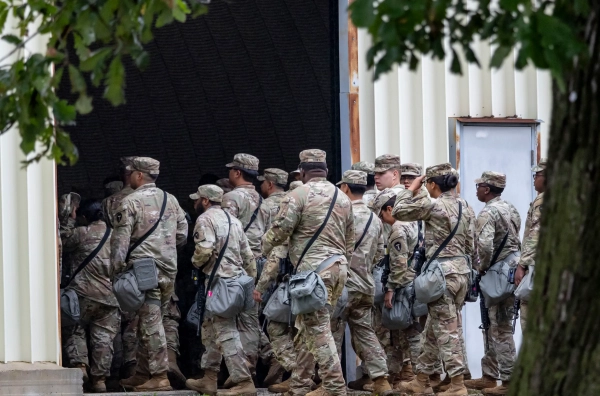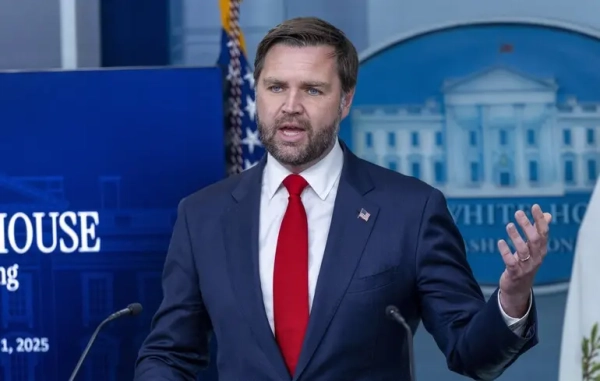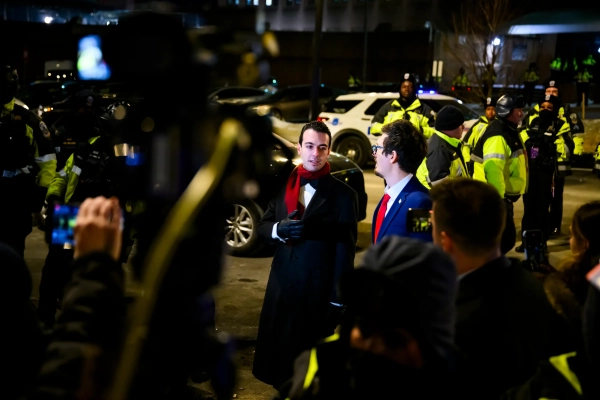
It’s difficult to envision a more momentous query than the matter presently before the Supreme Court in Trump v. Illinois.
President Donald Trump desires to utilize federalized armed forces to subdue demonstrations occurring outside an immigration holding center in the vicinity of Chicago. Two federal tribunals have declared that federal legislation does not authorize Trump to do so. However, the case is now being reviewed by a Supreme Court, the majority of which is composed of six Republican justices who rarely diverge from the viewpoint of their political party’s leader.
SCOTUS, Explained
Obtain the most recent insights into the US Supreme Court from seasoned correspondent Ian Millhiser.
Email (required)Sign UpBy submitting your email, you agree to our Terms and Privacy Notice. This site is protected by reCAPTCHA and the Google Privacy Policy and Terms of Service apply.
Furthermore, Trump’s justifications in the Illinois proceedings are notably assertive. His legal representatives assert that the consideration of when the president can exert his authority to assume command of National Guard personnel, who are typically under the direction of state authorities, “is consigned solely to the president” and cannot be assessed by federal courts. Trump’s attorneys also maintain that, once Trump acts, “the Guardsmen operate under the command and control of federal military officials and, ultimately, the President as Commander in Chief.”
Consequently, should the justices embrace this contention, Trump could potentially acquire unrestricted jurisdiction to activate the National Guard and instruct armed guardsmen to “safeguard” voting locations in Democratic-leaning regions of the nation.
The case stems from Trump’s determination to place several hundred members of the Illinois and Texas National Guard under his jurisdiction and direct them to an immigration holding facility in Broadview, Illinois, situated approximately 12 miles west of Chicago. Since September, a small collection of individuals has protested against the Trump administration’s immigration strategies outside that facility, and some have allegedly committed acts of vandalism against federal law enforcement vehicles. Additionally, some individuals have been apprehended for severe offenses, such as aggravated battery.
According to Judge April Perry, a federal district judge who provisionally impeded this deployment, “the average number of demonstrators is less than fifty,” and “the total count has never surpassed 200.”
To validate Trump’s choice to station military staff in an American city, his attorneys depend on a federal statute that permits the federal government to take command of National Guard members if there is “a rebellion or threat of a rebellion against the authority of the Government of the United States” or if “the President is unable with the regular forces to execute the laws of the United States.”
In essence, Trump asserts that a modest gathering, ranging from a few dozen to a couple of hundred individuals, has so overwhelmed the United States’ capability to enforce its own laws that it justifies deploying the military against US citizens on US land.
Related
- The compelling evidence indicating that the Supreme Court is aligned with Donald Trump
Undeniably, the implications in the Illinois lawsuit are astounding. Should Trump be permitted to employ military personnel to suppress a minute group of protesters and vandals, it is doubtful that this Court will enforce any meaningful restrictions on his capacity to deploy the US military against Americans.
What does the legal framework genuinely stipulate regarding presidential utilization of the National Guard?
To fully comprehend the Illinois case, it is beneficial to initially grasp how the authors of the original Constitution conceptualized the function of the military.
The framers harbored substantial apprehensions that military force would be directed towards the nation’s own citizenry or against state administrations that diverged from the federal government’s leadership. In fact, their concerns were so profound that they envisioned a nation devoid of a perpetual national army. This accounts for the Constitution’s prohibition against Congress appropriating funds to the army for durations exceeding two years.
As the Supreme Court articulated in Perpich v. Department of Defense (1990), the framers widely feared that a national standing Army constituted an unacceptable hazard to individual autonomy and the self-governance of the individual States.”
Nonetheless, the framers did contemplate that each state would uphold a militia — which, under conditions stipulated by Congress, could be summoned into federal service “to execute the Laws of the Union, suppress Insurrections and repel Invasions.”
Although the United States’ military capability and its acceptance of standing armies have conspicuously burgeoned since the nation’s inception, federal law persists in reflecting the framers’ apprehension regarding the use of military personnel to oppress the populace or encroach upon states’ internal affairs.
While the president may, in specific limited circumstances, instruct the National Guard (the contemporary manifestation of founding-era militias) to serve on US territory, such directives are intended to be a measure of last resort. The relevant statute exclusively permits such deployment of the National Guard to fend off a foreign incursion, to quash a rebellion, or when the president is “unable” to otherwise implement US law.
Trump, however, implores the Supreme Court to interpret these constraints as entirely inconsequential. His central argument is that he can simply assert that a rebellion or comparable exigency exists, and the courts are powerless to intervene, even if that pronouncement is preposterous. Conversely, he requests the justices to construe terms like “rebellion” or “unable with the regular forces to execute the laws of the United States” so broadly that they encompass a small demonstration that has never exceeded a couple of hundred participants.
Related
- How the Supreme Court positioned ICE above the law
Trump’s initial contention emerges from a singular phrase in the Court’s ruling in Martin v. Mott (1827) that, if scrutinized in isolation, does appear to bolster his sweeping assertion of authority over the National Guard. Martin pertained to a prior iteration of the federal statute governing presidential command of the militia, and one sentence of that opinion avows that the “authority to decide” whether activating the militia is justified “belongs exclusively to the President.”
However, as both federal tribunals that adjudicated the Illinois case determined, Trump’s legal team extrapolates this phrase out of context. Martin concerned a member of the New York militia who defied President James Madison’s instruction to report for federal duty during the War of 1812. In that instance, the Supreme Court posed a question: “Is the President the sole and exclusive judge whether the exigency has arisen, or is it to be considered as an open question, upon which every officer to whom the orders of the President are addressed, may decide for himself, and equally open to be contested by every militiaman who shall refuse to obey the orders of the President?”
The Court then resolved that question with the phrase Trump’s attorneys cite, affirming that the president possesses the authority to determine whether to federalize the militia; this authority is not vested in each individual within that militia. Consequently, Martin does not substantiate the notion that courts can never assess whether a president’s decision to activate the National Guard adheres to federal law. It simply maintained that members of the militia cannot independently resolve whether to report for duty.
This leaves Trump’s assertion that a minor assembly of pro-immigration protesters equates to a “rebellion,” or a mob that so menaces the United States that the law will cease to operate unless military personnel suppress that mob.
The latter declaration is patently absurd. As Judge Perry observed, “federal immigration officials have witnessed substantial increases in arrests and deportations,” notwithstanding the presence of several dozen individuals protesting outside a solitary immigration holding center in Illinois. Therefore, the government appears to be enforcing its laws effectively.
Correspondingly, Judge Perry characterizes the term “rebellion” as “a deliberate, organized resistance, openly and avowedly opposing the laws and authority of the government as a whole by means of armed opposition and violence.” Thus, mere transgressions of the law, or even actions intended to impede federal officials from executing their responsibilities, are insufficient. The purported rebellion must genuinely jeopardize the “authority of the government as a whole.”
That definition is logical, considering that the term “rebellion” is nestled within a statute also targeting foreign invasions or substantial uprisings that threaten anarchy. Consequently, it is reasonable to interpret the term “rebellion” as encompassing analogous perils to national security or US stability. A restrictive definition of the term “rebellion” is also rational in light of the United States’ historical unease regarding the deployment of military forces on domestic terrain.
Will that suffice to sway this Supreme Court? Probably not, considering the Republican justices’ extraordinary deference toward their political party’s leader. Nonetheless, a decision authorizing Trump to deploy the National Guard to suppress a minor demonstration would represent a marked departure from the nation’s legacy of circumspection concerning domestic deployment of the armed forces.
The Illinois proceedings may hinge on whether the Trump administration can be trusted
In its brief to the justices, the Trump administration insinuates that there has been a disintegration of order outside the Broadview facility. They assert that “federal law enforcement agencies have been compelled to operate under the perpetual menace of mob brutality and to reroute resources from enforcement operations to shield federal agents and property.” Concurrently, the Trump administration alleges that “local forces have failed to respond, or have inexplicably delayed their response, even when federal agents encounter life-threatening aggression.”
Conversely, both the Illinois plaintiffs and state and local law enforcement present a more intricate portrayal. From their vantage point, while demonstrators have occasionally participated in illicit conduct, state and local law enforcement have been attentive to the federal government’s requirements, and much of the animosity near the facility was precipitated by inadequate policing on the part of federal officials.
Judge Perry encapsulated the Broadview Police Department’s stance, indicating that they surmise that the “demeanor of the protesters” worsened following a display of force by federal officials; “twenty to thirty federal agents positioned themselves across the street and proceeded towards the ICE Processing Center clad in camouflage tactical attire with masks concealing their faces.” Broadview Police also voiced grievances that federal officials’ “application of chemical agents against protesters ‘has frequently been arbitrary and indiscriminate,’ occasionally targeting groups as small as ten individuals.”
Perry inferred that the state and local law enforcement’s interpretation of events is more plausible than the Trump administration’s. Among other considerations, she remarked that certain declarations submitted to her court by the Trump administration contain factual inaccuracies or otherwise dubious assertions. For instance, two of Trump’s witnesses “allude to arrests effectuated on September 27, 2025, of individuals who were brandishing weapons and assaulting federal agents,” but “neither declaration discloses that federal grand juries have declined to return an indictment against at least three of those individuals, which is tantamount to a determination of a deficiency of probable cause that any crime occurred.”
Judge Perry’s determination that the Trump administration lacks credibility and that the state and local law enforcement’s version of events is valid carries weight because appellate tribunals are only authorized to dispute a trial judge’s factual findings if they are “clearly erroneous.” Consequently, the Supreme Court should presume that the Trump administration’s depiction of extensive turmoil outside the Broadview facility is inaccurate.
However, numerous Republican justices openly exhibit animosity toward district judges who do not espouse their perspectives. And those justices are particularly trusting of Trump and his administration, notably in cases involving law enforcement.
Therefore, there is a tangible likelihood that the Republican justices will resolve the Illinois case by simply presupposing that order has dissolved in Broadview and subsequently interpreting the law as though Trump’s claims are sacrosanct. In the direst scenario, they could also mandate that lower courts defer to Trump even if he deploys the military to suppress dissent or to intimidate Democratic voters.
Source: vox.com






